Green manure is a green fertilizer. Green manure
Green manure refers to green manure plants that are temporarily grown in open, unoccupied areas of soil or as an adjacent crop. The functions of green manure are to improve the structure of the soil, prevent leaching and weathering from it nutrients, suppression of weed growth, as well as enrichment of the soil with nitrogen. The process of sowing, growing and storing green manure in the soil is called green manure.
One of important rules organic farming - should not remain unused and open. Long-term (for weeks or longer) open areas soils are subject to significant structural deterioration and depletion. Aimlessly abandoned open ground in the garden, over time, it hardens, sticks together and becomes covered with a dense crust, through which moisture hardly penetrates into the depths. The organic composition deteriorates, nutrients are washed out and eroded. In the complete absence of control and competition, a massive dominance of weeds begins, which also use useful substances from the soil, giving it nothing in return. Subsequently, the gardener has more work, since now it will take several weeding, digging and fertilizing to make the site usable again. Obviously, it was better to take care from the beginning so that the soil did not remain open.
Here sideration comes to the aid of the gardener - a technology known to farmers from ancient times. According to the results of their impact on the soil, green manure crops can compete with manure, so they are simply irreplaceable for those farmers who fundamentally do not want to use animal waste for fertilizing vegetables and fruits.
How siderates work
Green manure crops develop dense, fast-closing foliage that inhibits weed growth. Some of them (for example, rye) have interesting feature delay the germination of other seeds and, thus, suspend the process of the emergence of new weeds for several weeks. The green manure has a well-developed and highly branched root system, which improves the structure and water permeability of the soil: penetrating deep inside, it loosens and enriches heavy clay soils with air and supports light, sandy soils from decay. Developed roots also help to deliver nutrients from deeper layers of the soil upward, closer to the roots of edible or ornamental crops, between which "green fertilizer" is grown. Siderata have the peculiarity of enhancing the effect of other fertilizers and accelerating microbiological processes in the soil.

Siderata planted among vegetable crops partially take the blow garden pests, and partially discourages them from landing, simply confusing them. At the same time, the bright and full of nectar flowers of most green manure crops - magnificent honey plants - are able to attract bees and bumblebees to planting, which simultaneously pollinate the fruits and vegetables growing in the neighborhood. Plants from the legume family are considered the most effective "green fertilizer". Special bacteria that live in their root growths have the ability to accumulate nitrogen, which they receive directly from the air and deposit in the soil.
Where and when is green fertilization applied:
- Between other edible or ornamental plants, in the voids
- As an adjacent early ripening crop among long ripening crops (for example, parsnips, root celery, leeks, etc.).
- Between harvesting old crops and new plantings
- In the off-season, at the end of summer or in autumn before winter
- For resting the soil from intensive use for a whole year
Selection of green manure crops
The choice of a particular crop for sowing as a "green fertilizer" depends on factors such as the composition and structure of the soil in your garden, for how long you intend to use green manure, etc. If you use a rotation (alternation) of vegetable crops, then every season is near sow green manures from the same family with vegetables. Thus, the "green fertilizer" will partially take over the possible attacks of harmful microorganisms and insects infecting this family, and will rid your vegetables of them. The choice of suitable green manure crops also depends on whether there are this moment the need to enrich the soil with nitrogen. The table below provides more detailed information about the various siderates and their features.
| Sideral culture | Preferred soil type | Nitrogen retention | Growing cycle / sowing time |
| Alfalfa blue (Medicago sativa) | Except acidic and moist | Yes | From year |
| Hop-like alfalfa (Medicago lupilina) | Except sour | Yes | From 3 months |
| Horse beans (Vicia faba) | Heavy | Yes | Before winter |
| Vika, sowing peas (Vicia sativa) | Except sour and dry | Yes | 2-3 months |
| Meat-red clover (Trifolium incarnatum) | Lungs | Yes | 2-3 months before winter |
| Red clover (Trifolium pratense) | Rich loam | Yes | 3-18 months |
| Hay fenugreek, Greek hay (Trigonella foenum-graecum) | Moisture permeable | Yes | 2-3 months |
| Lupine narrow-leaved and other species (Lupinus angustifolius) | Light sour moist | Yes | 2-4 months |
| White melilot (Melilotus albus) | Any, incl. poor | Not | Before winter |
| Sandy sainfoin (Onobrychis arenaria) | Any, incl. poor | Yes | From year |
| Sowing rank (Lathyrus sativus) | Yes | 2-4 months |
|
| Horned lyadvenets * (Lotus corniculatus) | Any | Yes | From year |
| Seradella sowing (Ornythopus sativus) | Any wet | Yes | 2-4 months |
| Buckwheat edible (Fagopyrum esculentum) | Any, incl. poor | Not | 1-3 months |
| Phacelia tansy (Phacelia tanacetifolia) | Any | Not | 1-3 months |
| Sowing rye ** (Secale cereale) | Any | Not | Before winter |
| White mustard (Sinapis alba) | Any, incl. poor | Not | 1-2 months |
| Comfrey (Symphytum) | Any | Not | From year |
| Oil radish (Raphanus sativus) | Heavy, clayey | Not | 2-3 months |
| Rape (Brassica napus) | Heavy, clayey | Not | Before winter |
* Only n and empty plots of land
** Only after the emergence of the main crop
Recently, very decorative cultivars of meadow and meat-red clover have appeared, which, in addition to being useful as a siderat, will serve as an excellent decoration for the garden. With the modern garden fashion for modest meadow, field and forest plants, decorative clovers will perfectly fit into the natural design.

Using "green fertilizer"
When you are ready to use an empty piece of land again, slightly dig or plow the soil along with the green manure to a depth of 15 cm. " Green manure"crumbles a little and remains in the soil or on its surface. By decomposing faster than conventional crops, green manures serve additional source humus, fertilizer, moisturizing and baking powder for the soil.
If you are growing vegetables on raised ridges using the non-burning method, then simply cut or pluck out the green manures and leave them here, covered with another layer of mulch.
The efficiency of green manure use can be further increased. In areas where "green manure" will spend several months or even a year, do a few haircuts. Siderata will quickly grow back, and you will have an excellent natural fertilizer which can be buried in the soil or spread on the surface elsewhere, or added to garden compost... The role of green manure crops in compost cannot be overestimated: due to their high nitrogen content, they accelerate the composting process, increase the content of nutrients and improve the structure of the finished compost.
The use of "green fertilizer" is an excellent natural, ecological method of improving soil quality and increasing the yield of any crop at a low cost and relatively low labor costs. A valuable tool in the organic gardener's arsenal!
If you liked this material, then we offer you a selection of the most best materials of our site in the opinion of our readers. A selection - TOP about existing eco-settlements, Ancestral estates, their history of creation and everything about eco-houses, you can find where it is most convenient for youIn order for the soil to be fertile, it must be "fed" with organic matter, i.e. for her we must grow special plants, leave plant residues or make organic fertilizers... The quality of soil fertility depends on the energy of the buried organic matter.
Experienced agronomists understand this pattern well, and try not to leave the field without "food". The organic matter buried in the soil will be processed by microorganisms, and in subsequent years new plants will use its energy. Thus, the soil is a kind of energy store for the future harvest.
In agronomic practice, green manure plants are grown especially for "feeding" the soil. They are sown in any free intervals of the growing season, when the main crops do not grow on the site.
Not a single day should the soil "walk" without plants: on a bare bed, humus burns out in the sun. To protect against this adverse phenomenon, experienced gardeners use post-harvest, post-harvest and stubble crops of green manure.
Siderata, especially perennial (clover, alfalfa, sylphia), are sometimes grown in a separate area, where they are mowed, crushed and then brought to desired site... So it is recommended to use beveled lawn grass- bring it to the garden and dig in, resulting in green fertilizers.
Green fertilizers include any fresh grass (this can be young shoots and leaves after cutting shrubs), mowed and transferred to the garden bed. Siderata also belong to green fertilizers, but they are specially sown and dug up at a certain stage of development at the place of their growth.
If we compare green manure with dug green mass and manure, then the effect of them is the highest, since an additional beneficial effect of the root system is manifested.
Pros and cons of siderates
Growing any crop has its pros and cons. This applies to green fertilizers in general and green manure in particular. TO positive properties should include the following:
- the soil becomes a habitat for beneficial microorganisms and earthworms that feed on plant residues;
- permanent cover of the soil surface protects it from degradation;
- erosion protection, especially under perennial plants and on the slopes;
- rye and other plants left for the winter contribute to snow retention;
- many siderates (mustard, oats, annual ryegrass, alfalfa, clover) have a deep root system, which extracts calcium, phosphorus, magnesium and other macro- and microelements from deep into the upper layers of the soil;
- regulate the ratio of nutrients, and legumes also enrich the soil with nitrogen;
- when rotting green fertilizers, a large amount of carbon dioxide which vegetable plants use for photosynthesis;
- green manures are competitors for weeds that cannot withstand shading and allopathic influences (i.e., cannot withstand the effects of chemical excretions);
- some plants (mustard, radish, tagetes) regulate the number of nematodes;
- ultimately, fertility is restored and increased;
- practically do not require chemical protection from diseases and pests (only in very hot and dry weather, a cruciferous flea attacks the seedlings of mustard and radish).
Naturally, in the many years of work with green manure, some of them were noted. negative properties, namely:
- some green manure plants share common pests and pathogens. This is especially true for plants of the cabbage family (for example, cruciferous flea beetle, keela, bacteriosis), legumes (weevil, aphid) and oats (common nematode species with root plants);
- if they are late with incorporation into the soil, some green manures have time to seed and clog the garden bed;
- in case of a delay with the incorporation of green mass and its lignification (for example, rye left before flowering), additional application is required nitrogen fertilizers;
- there are no universal green manures in relation to acidity and granulometric (sandy or clayey) soil composition;
- there are no universal green manures in terms of sowing time, care and time of incorporation into the soil;
- green manures are also plants and require watering and additional fertilization;
- additional costs for soil preparation, purchase of seeds and their incorporation into the soil;
- the visible positive effect is not clearly manifested, but often stretches over several years.
General secrets of green manure technologies
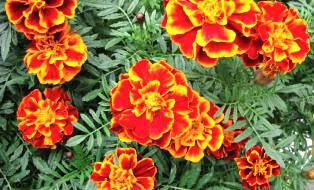
The use of green manure in the garden has general agricultural principles, regardless of the type of plants and soil. It should be noted that the technological methods recommended in the scientific and industrial literature for use on large farms are not always suitable for the gardener and gardener.
The use of green manure should start with careful planning of the alternation. vegetable plants in the garden, so that after digging them, 2-3 weeks remain before the next sowing. If the weather is dry, then watering is carried out before sowing, and after sowing the soil is rolled up.
Seeding rates are regulated according to the following principle: if green manure is planned to be dug up at a younger age, then the seeding rate should be higher. Apply different ways sowing: by hand and with a manual seeder, in rows or randomly. It is advisable to grow Tagetes by seedlings.
It is advisable to grow perennial green manure plants (alfalfa, clover, sweet clover, sylphium) for green fertilizers in perennial culture, and transfer the mown green mass to the garden bed, but in this case, the effect of additional loosening of the upper soil layer by the root system and the transfer of nutrients from the lower soil layers is excluded ...
Perennials become siderates in Last year after the aftermath regrowth Green manure plants do not require special seed preparation, except for processing legumes with nitragin. The decay of green mass is facilitated by its processing before digging with preparations of beneficial microorganisms (for example, Baikal EM).
Siderata do not require chemical protection against pathogens and pests, except cruciferous flea against which watering and spraying are effective cold water... Digging in siderates is carried out manually or with a walk-behind tractor.
If the plants are not tall, then it is convenient to work by hand with a pitchfork. Tall plants are first bent down, crushed and added dropwise with a sharp shovel. When using a walk-behind tractor tall plants it is advisable to first install by rolling.
Legume siderates
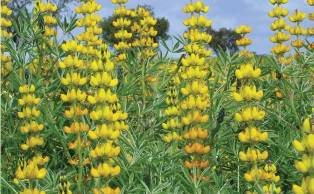
A very valuable group of green manure, which gives a large green mass and, thanks to nodule bacteria, assimilates atmospheric nitrogen. This is a large group of plants that differ in biological characteristics.
Among them there are annuals and perennials, demanding for heat and cold-resistant, with a different range of requirements for soil acidity and moisture. It is advisable to process legume seeds before sowing. bacterial preparations nodule bacteria that are developed for each species.
Leguminous siderates are not used before growing vegetable varieties of peas, beans, cowpea, tetragonobus, soybeans and other legumes.
Lupine ... For siderates, various annual types of lupine are used: narrow-leaved, or blue, yellow and white. For green fertilizers, you can also use mowed young plants of perennial lupine.
Different types of lupine show unequal demands on heat: the most demanding is white, and the least narrow-leaved. Withstand frosts down to minus 5-6 ° С, and perennial winters well. All species are demanding on moisture and easily tolerate high soil acidity, but react poorly to salinity, high calcium content and waterlogging.
The sowing method is narrow-row. Seeding rate: yellow up to 1.75 kg / 100 m2, narrow-leaved - up to 2.0 and white - up to 2.3 kg / 100 m2. Lupins are legumes that carry the cotyledons to the soil surface, and therefore the depth of planting seeds, despite their size, should be up to 5 cm. With deeper planting, seedlings are thinned out.
It is instilled in at the beginning of the formation of the beans. The yield of green mass is up to 3-4 kg / m2.

Peas ... Annual. To obtain siderates, varieties of grain and fodder, or pelushka, are used. Post-harvest residues of vegetable and sugar varieties are an excellent green fertilizer. If grain, vegetable and sugar peas have white flowers, then pelushka has red-purple flowers and speckled angular seeds.
Peas are cold-resistant plants with a short growing season. Demanding on moisture, but does not tolerate waterlogging and acidic soils. In the initial phases of development, it is weakly competitive with weeds.
Sowed from early spring to early September. The sowing method is narrow-row, with a row spacing of 15 cm. Sometimes it is sown together with oats, barley or mustard. Seeding rate in clean sowing - up to 3 kg / 100 m2. The seeding depth is 6-7 cm, and on dry soils it can withstand a deepening of up to 8-9 cm.
It is instilled in the phase of mass bean formation or after harvesting of vegetable and sugar sorts of beans-shoulder blades. The yield of green mass is up to 2 kg / m2, and of tall varieties - even up to 3 kg / m2.

Broad beans... Annual. To obtain green manure, small-seeded fodder varieties are used. The green mass of vegetable varieties with large seeds is also used in the same way, i.e. crushed and added dropwise only after harvesting the shoulder beans.
Beans are cold-tolerant and moisture-demanding plants. They react negatively to soil acidity. Sowing dates are from early spring to early September. The sowing method is wide-row - up to 40-45 cm. The seeding depth is 6-8 cm. The seeding rate strongly depends on the size of the seeds, therefore 40-50 pieces are sown. / m2.
Care consists in loosening row spacings and watering. Close up in the soil after the formation of the beans on the first tier. The yield of green mass is up to 3-4 kg / m2. In addition to clean crops, it works well in mixed crops with peas, vetch and corn.
Vegetable beans ... An annual plant that is demanding on heat and moisture. The green mass of plants is usually used as green manure after harvesting the beans on the shoulder. In the gardens, beans are grown on a shovel, after harvesting which the green mass is crushed and added dropwise. The yield of green mass is up to 1.5 kg / m2.
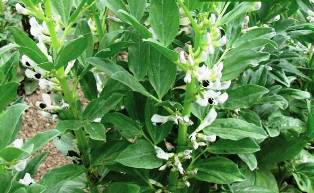
Vigna , or cowpeas. For green manure, grain varieties with small seeds are used. Vegetable varieties are also used after harvesting shoulder beans. Demanding heat. Drought-resistant annual, which allows it to be successfully used in southern horticulture. Techniques for growing cowpea, like beans. Sowed from early May to mid-July. Seeding rate - up to 0.5 kg / 100 m2. The yield of green mass is up to 2 kg / m2.
Vika spring and winter , or furry. In order to enrich cereal green manures (barley, oats and rye), experienced gardeners always sow vetch with them. Spring vetch is sown from early spring to late August, and winter vetch is sown together with winter rye. The vico-oat mixture is added dropwise at the beginning of flowering. On the roots of the vetch, nodule bacteria develop well, which enrich the soil with nitrogen.
Depending on the availability of seeds, different proportions of seeding rates are selected. Usually, 1 kg of spring vetch and 0.5 kg of oats are used per 100 m2. An excellent yield, up to 5 kg / m2, gives a vetch-oat-ryegrass green manure mixture (1.4 kg of vetch, 0.7 kg of oats and 0.3 kg of annual ryegrass per 100 m2).
The peculiarities of joint sowing of winter vetch and rye include some discrepancy between the phases of development of these plants. Therefore, winter vetch is sown 15 days earlier than rye (seeding rate - 1 kg / 100 m2), at a depth of planting of its seeds by 3-4 cm.After vetch germination, rye is sown across the rows, reducing the seeding rate to 0.8 kg / 100 m2 ... Vico-rye mixture winters well, and it is added to the green manure in the first half of May, before the earing of rye begins.
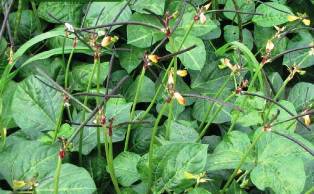
Seradella , or bird's foot. On light sandy soils for green manure, this annual, very valuable bean plant... The advantages of seradella include the ability to withstand shading, which allows it to be sown between rows of sweet corn and orchard. It grows back quickly after mowing.
It is not demanding on heat and can withstand frosts down to minus 8 ° C. An excellent honey plant, giving bribes until late autumn. Flowering begins 40 days after germination. The sowing method is narrow-row (row spacing - 15-20 cm) at a seeding rate of 0.5 kg / 100 m2. The yield of green mass is up to 2.5 kg / m2.
Mushroom herb, fenugreek ... Two types are used - hay fenugreek and blue. The first species is undersized, with long beans (up to 15 cm) and large seeds, and the second is tall (up to 70 cm), with small beans (only up to 0.5 cm) and small seeds.
These two annual species are grown to produce the mushroom herb spice, medicinal raw materials and feed. In the garden, they can be successfully used to obtain green manure. These species are relatively drought-resistant. Do not tolerate acidic soils.
Sow in April-July. The method of sowing blue fenugreek is wide-row, with row spacing up to 40 cm, and hay - somewhat narrower, up to 30 cm. The seeding rate of hay fenugreek is up to 0.5 kg / 100 m2, and blue - 0.3 kg / 100 m2. The seeding depth is up to 2 cm. The yield of green mass is higher in blue fenugreek and is up to 2 kg / m2, and in hay - up to 1 kg / m2.
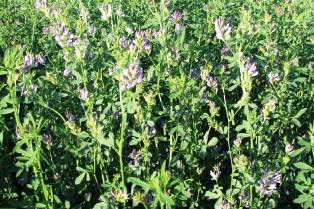
Alfalfa ... Like others perennial species, it is advisable to grow alfalfa on the plot for 2-3 years. In the early years, it is mowed, and the green mass is transferred for green fertilization to another area, and at the end of use it is dug up like green manure.
High heat and drought resistance allows it to form a high yield of green mass without irrigation. Salt-tolerant and brines saline soils. She is demanding on light and cannot withstand shading. Does not tolerate swampy and acidic soils.
The seeding rate in conditions of moderate moisture is up to 150 g / 100 m2, and in the steppe zone - up to 120 g / 100 m2. Seeding depth is not more than 3 cm. Sowing method - randomly or wide-row, with a row spacing of 25-30 cm. It will grow back well after mowing. Provides up to five mows per growing season. The total yield of green mass for all cuttings is up to 7 kg / m2.

Different types clover ... Perennial red clover is usually used, although annual species for southern truck farming are also quite suitable: Shabdar, Alexandrian and incarnate. Red clover is used like alfalfa, and annual species are dug up in the year of sowing.
All types of clover require moderate moisture. More shade-tolerant than alfalfa. The optimum soil response is neutral and slightly acidic. Clover gets sick when it is re-grown in the same place. Sowing is repeated after 4-5 years.
Growing techniques are the same as for alfalfa. The yield of green mass in the second year of cultivation is up to 4 kg / m2. For southern irrigated areas, annual types of clover are great. shabdar and bersim, and for northern and western - clover incarnate, but the latter grows poorly and gives one cut.
Clover white, or creeping, which is used to decorate some types of lawns, is not used specifically for green fertilizers, but the grass mown on the lawns is transferred to the beds for green fertilization.
Melilot white and yellow ... Biennial plants that are frost, drought and salt tolerant. Does not withstand waterlogging and acidic soils. The stem grows woody quickly, so it is mown at the beginning of flowering.
Donnik is an excellent meliorator. Its roots penetrate up to 3 m, loosening the subsoil layers and moving the useful nutrients and from the bottom layer to the top. Seeding rate - up to 250 g / 100 m2.
In the first year of life and from the first mowing to the second, green mass is used for green fertilizer, and the aftermath is dug into green manure. The yield of fresh, non-lignified green mass, suitable for green fertilization, is high and amounts to 4 kg / m2.
Cereal siderates
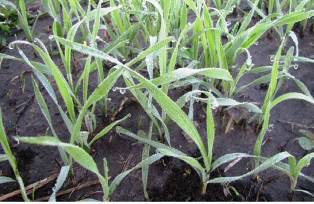
Winter rye . Favorite plant gardeners for late autumn and early spring green manure. Cold and frost-resistant plant with a well-developed superficial root system, which perfectly loosens the upper layers of heavy soils. It bushes well, which helps to suppress weeds.
Features to consider for gardeners: very fast growth in height in spring, which can cause overgrowth of the green mass. An excellent predecessor for everything vegetable crops... For siderates, rye begins to be sown in August and continues until mid-October.
Summer crops of rye are used for autumn digging, and autumn crops for spring. Seeding rate for green manure up to 2.5 kg / 100 m2. The seeding depth on heavy and moist soils is up to 4-5 cm, and on sandy and dry soils - up to 5-6 cm. Deeper seeding weakens young rye plants.
The yield of green mass fluctuates up to 1.0 kg / m2 in autumn and up to 3 kg / m2 during heading. Rye is an excellent precursor for all vegetable plants, but in case of a delay in planting in spring, the green mass quickly coarsens, which requires additional nitrogen fertilization during digging.
Barley ... Usually, spring varieties are used for spring green manure, and winter varieties for autumn and spring, like rye. Cold-hardy, but spring varieties freeze out. It is drought-resistant in comparison with other cereals. Poorly tolerates acidic and sandy soils. The root system is not sufficiently developed and poorly uses inaccessible reserves of phosphorus and potassium, therefore phosphorus-potassium fertilizers are desirable for it.
Growing rapidly. Loosens perfectly upper layer soil. Spring barley is sown in early spring... Dig in at the end of May. The beds are used for summer crops root crops, green crops, sugar corn, vegetable marrow, summer potato planting, different types cabbage. Sometimes sown in August to obtain autumn green manure.
It bushes well even with autumn crops, but due to the length of the day, it does not turn to earing. Can be left in the garden before winter. In this case, the spring varieties freeze out, but they perfectly retain the snow.
The seeding rate for obtaining green manure is 2-3 kg / 100 m2. The sowing method is narrow-row. The seeding depth of seeds on heavy soils is up to 3-4 cm, and on sandy soils - up to 6 cm.The yield of green mass depends on the phase of plant development: in the tillering phase - up to 1.0 kg / m2, in the heading phase - up to 2.5 kg / m2.
Oats ... Cold-resistant and demanding on moisture, but does not tolerate high summer temperatures... Sow in early spring. Often used in mixtures with peas and spring vetch, this approach contributes to the enrichment of the soil with nitrogen.
It is characterized by a very rapid development of the root system, which extracts nutrients from poorly soluble forms and deep layers of the soil. Insensitive to the acidity of the soil solution.
The technology of cultivation and use is close to the technology of growing barley, but it should not be sown either before or after the root crops with which it has general views harmful nematodes. In addition, the sowing depth should be somewhat shallower.
Westerwold annual ryegrass ... An excellent green manure for different types of soil with a wide range of acidity, except for very light and quickly drying sandy ones. It has no analogues among cereals in terms of growth rate. The best sowing time is early spring.
Seeding rate - 0.3 kg / 100 m2. The sowing method is narrow-row. The seeding depth is up to 3 cm. It grows well after mowing, which allows it to be grown on a separate site, followed by transportation of the green mass to the desired place. Productivity - up to 3 kg / m2. An excellent precursor for all vegetable plants. Seeding of plants should not be allowed, otherwise contaminating self-seeding is possible.
Cabbage and other green manure plants
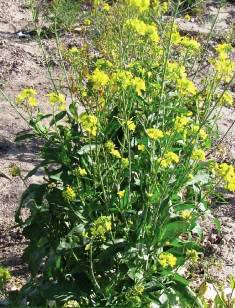
Mustard ... To obtain siderates, two types of mustard are used: gray and white. Biological features their very close ones. White mustard has small pale yellow seeds (1000 seeds weigh 5-6 g), and gray mustard has large dark brown seeds (1000 seeds weigh up to 25 g).
The root system is deep and has a strong digestible capacity. Does not tolerate very acidic, heavy and waterlogged soils. Blue mustard, due to its increased drought resistance, we recommend growing on green manure in more southern regions, and white mustard - in fairly humid northern and western regions.
Sowing dates: from early spring to mid-September. The seeding rate for white mustard is 200 g / 100 m2, and for gray mustard - up to 150 g / 100 m2. The seeding depth is 2-4 cm. After sowing, the soil is rolled up. In dry and hot weather, young plants are severely damaged by the cruciferous flea.
The yield of green mass during the period of mass flowering is up to 4-5 kg / m2. Due to common diseases and pests, mustard cannot be a precursor for all types of cabbage, radish and radish.

Buckwheat ... Excellent green manure. The seeds germinate quickly and suppress weeds. After 25-30 days, it begins to bloom and attracts pollinators to the garden. Demanding on heat and moisture. Develops a deep root system and extracts hardly soluble nutrients from the deep layers of the soil, but does not tolerate the high acidity of the soil solution.
Does not fix nitrogen, but converts insoluble phosphorus compounds of soil and fertilizers into readily available forms for subsequent vegetable plants. Sowing dates for green manure: from late April to early September.
They are dug in at different stages of growth, but preferably before mass flowering, when the stem is not yet lignified. After digging, it inhibits the germination of seeds of carrots, parsley and parsnips, but does not affect the planted seedlings of other vegetable plants.
The seeding rate is 1 kg / 100 m2. The seeding depth is up to 5 cm, and on light and dry soils it is increased to 6-7 cm. The yield of green mass at the beginning of flowering is up to 2.0 kg / m2, subsequently it increases, but the buried green mass decomposes more slowly.
Phacelia tansy ... Demanding heat. The height of plants during the period of mass flowering is up to 80-90 cm. Excellent honey plant. Seeding rate - 100 g / 100 m2. The seeding depth is 2-3 cm. The sowing method is narrow-row (15-20 cm) or wide-row (30-45 cm).
Crushed and dug up during the period of mass flowering. The last sowing period is 60 days before the first autumn frosts. It quickly decays in the soil. The yield of green mass is up to 2 kg / m2. An excellent precursor for all vegetable plants.
Tagetes , or black shaves. Demanding on heat and moisture. Requires neutral soils. An excellent phytosanitary that cleans the soil from nematodes. The only green manure that requires planting through seedlings. Usually, tall varieties are used, which give a large green mass.
Seedlings are grown in a separate bed, in a seedling box or greenhouse and planted on permanent place vacated beds. With a sufficient number of seeds, tagetes can also be grown in a seedless way.
The seeding depth of seeds is no more than 1.5-2.0 cm. The planting pattern of seedlings depends on the height of adult plants and is usually 45x30 cm. Crushed and dug up as needed, or late autumn... An excellent precursor for all vegetable plants.
Sylphia pierced-leaved ... Frost-resistant perennial from the Aster family, which is sown in the background of a plot with a row spacing of 70-90 cm.It grows well on different types soil, incl. and salted. Plant height - up to 2 m. It blooms beautifully with large yellow baskets.
Provides an exceptionally large green mass, the yield of which reaches up to 7 kg / m2. Mowed during mass flowering, crushed and applied to the required areas. In one place it grows up to five years. Grows well. To obtain high yields in the spring, fertilizing and watering are carried out annually. Very decorative. Green mass good fertilizer for most vegetable plants, except for the aster family (lettuce, chicory, scorzonera, oat root).
Weeds ... All fresh chopped and dug weeds are excellent green fertilizers. Two immutable rules apply to them. Firstly, they are crushed and dug up only before flowering (they quickly form seeds), and secondly, they avoid using perennials (wheatgrass, sow thistle, bindweed), the remnants of rhizomes, which will clog the garden bed even more.
Post-harvest residues cultivated plants, as an addition to green manure. After harvesting, each vegetable plant leaves a certain amount of valuable organic matter in the form of roots, stems and leaves. Of all vegetable plants, broccoli cabbage (7-9 kg / m2) and sweet corn (4-5 kg / m2) give the highest yield of green mass.
No matter how many plant residues, and whatever they are - dry or fresh, but they must be returned to the soil. The soil takes a long time to "digest" dry and lignified residues. When they are introduced into the soil, it lacks its own energy for the development of useful microflora.
Therefore, if a piece of straw, sawdust, crushed bark, and high-moor peat are added dropwise, then 30 kg of ammonium nitrate is added for each ton of organic matter, it can be replaced with an equivalent amount of fermented mullein or bird droppings.
Thus, having mastered the basic elements of the "magic" of fertilizing the beds with green manure, begin to actively maintain fertility on high level and get pure organic produce, vegetables and fruits, in any conditions. Help the soil regain strength.
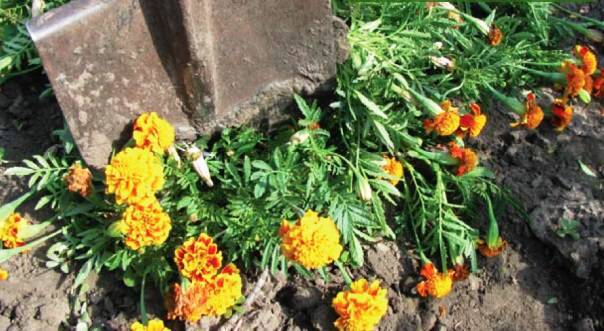
The word "siderates" has recently been heard more and more often in the conversations of gardeners. No wonder. Many owners summer cottages, who received a vegetable garden for their use, which had been a vegetable garden for twenty years, are thinking about restoring the fertility of the depleted soil. And green manure or green manure plants are one of the best helpers in this difficult task.
Behind the name "siderates" are hidden plants that can sprout quickly and gain green mass. It is this ability of theirs that gardeners use to get "green fertilizer" in a short period of time.
Green manure plants are usually planted before or after the main crop. Although proponents of natural farming advise certain vegetables (such as cabbage and tomatoes) to be grown in joint landings with siderates.
Early spring sideration most often they are used in beds for heat-loving crops with a planting period from mid-to-late May, for example, cucumbers, pumpkin, zucchini, late cabbage, etc. In order not to leave the ground bare, fast-growing cover plants (say, mustard or watercress). Before planting the main crop, the siderates will have time to gain enough green mass, which is mowed and used for mulching or compost. The roots of green manure plants are left in the ground. In order for soil microorganisms to have time to at least partially decompose plant residues, it is recommended to plant the main crop 2-3 weeks after mowing the green manure. To accelerate bio-processes during spring green manure, they are often used.
Autumn sideration- an excellent way to improve the soil and prepare it for cold weather. In this case, the cover plants are sown immediately after the main crops are harvested. Due to the fact that the earth is still warm in autumn, and the air is already cool, the plants try to make the most of the favorable conditions. So for the period from August to October, green manure grows on average 20-40 centimeters of greenery and 30 centimeters of roots. With the onset of cold weather, plants die, and worms, bacteria and other underground inhabitants come into play. Over the winter, all the organic matter is overheated, which means you can safely sow even the earliest vegetables like radishes and salads.
Successful sideration rules
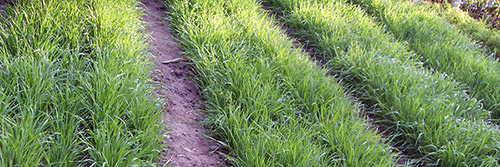
So that the use of green manure as a green fertilizer in your area gives maximum effect, and all your efforts were not in vain, you must adhere to several simple rules successful sideration:
1. Sow seeds into loose, moist soil.
2. Plants will sprout faster if the seeds are rolled a little, increasing their area of contact with the ground.
3. Protect the seeds from birds, place a scarecrow on the sown areas. Birds can easily peck at seeds scattered on the surface and nullify all the work.
4. Do not use plants of the same family for greening as the main crop you plan to plant. Plants of the same family suffer from the same diseases and consume the same substances from the soil.
5. Do not dig, do not embed the green mass into the soil. Digging disturbs the soil structure and destroys beneficial microflora. It is better to mow or cut off the green "tops" and put them on mulching, compost or.
6. For spring greens or joint plantings, cut the greens before flowering until a tough stem is formed. This stem decomposes slowly.
Useful properties of green manure

Why is sideration so useful? Why make so much effort, buy seeds, water, drive the birds away? It may be better to throw a bag around the area. mineral fertilizers and is the case ready?
Fertilization of the soil using green manure is the use of a natural mechanism for creating a fertile layer. Plants have provided and sustain themselves for centuries. They germinate, develop, die off and decompose, enriching the soil with nutrients for the next generations.
Therefore, provided that the soil is properly grown on your summer cottage will quickly "come to life" and turn into a full-fledged ecosystem. Well, no matter how many mineral fertilizers you put in it, the dead soil will remain dead - overdried, clayey, hard and depleted.
Green manure plants enrich the soil with organic matter, nitrogen, potassium, phosphorus and calcium in the form familiar to microorganisms.
Plants-green fertilizers stimulate development useful inhabitants vegetable garden, creating favorable conditions for the life of small insects, worms, bacteria, etc.
Siderata perfectly suppress weeds. With solid sowing, the ground part of the cover plants completely blocks the sun's rays from reaching the soil, preventing competing weeds from germinating.
The roots of green manure plants loosen the soil, improve its structure, increase moisture permeability, reduce acidity and deliver nutrients from the depths to the upper soil layer.
Covering plants form a continuous carpet on the garden bed, shade the soil, thereby protecting it from overheating in the heat. In addition, green manure prevents the evaporation of excess moisture from the soil.
Autumn green manure protects the ground from being washed away by rains and blowing off, contributes to less freezing of the soil in winter and retains snow on the beds for better moisture saturation in spring.
Some green manure plants contribute to the improvement of the soil, have a detrimental effect on pathogens and pests. When planting together with garden crops they scare away harmful insects with their phytoncides.
List of green manure plants

It seems it's time to finally find out which, in fact, plants are classified as green manure. Here is a list of the main ones:
- Legumes (annual lupine, beans, sainfoin, soybeans, lentils, seradella, peas, chickpeas, alfalfa, honeycomb, sweet clover, spring vetch, clover),
- Hydrophiles (phacelia),
- Cruciferous (mustard, rape, oil radish, rapeseed),
- Cereals (oats, barley, rye, wheat),
- Buckwheat (buckwheat),
- Astral (sunflower, calendula),
- Amaranth (amaranth).
In addition, garden stores sometimes come across special mixtures of green manure seeds. For example, vetch-oat mixture. And some flowers and even weeds can be used as green manure. For example, nettles, nasturtium or calendula. If you grow the seeds yourself and every year you find expired residues of seeds of dill, carrot, parsley, lettuce, etc., use them for greening. It's all in the case!
In the following articles Country councils we will consider in detail the properties of green manure plants and learn correctly.
We wish you success and big harvests!
In order to improve chemical and physical properties soil, increase its fertility, resort to phytomelioration.
Thanks to the use of phytomeliorant plants, the soil can be cleared of diseases and pests, weeds can be reduced, pollution can be reduced, etc.
Phytomeliorants include green manure plants and concentrator plants.
Green manure is grown as a green manure. This is one of the most effective ways restore soil fertility.
Legumes and other plants or mixtures thereof are used as green fertilizers. Legumes enrich the soil with nitrogen. The most commonly used green fertilizer is fodder peas, broad beans, narrow-leaved lupine, beans, phacelia, seradella, vetch, clover, yellow and white sweet clover.
Green manure can heal the soil. In this regard, the most suitable are plants of the Cruciferous family - radish, rapeseed, mustard, rape. They suppress the growth of weeds at the expense of their rapid development... In addition, pests such as wireworms do not like mustard, and marigolds and spring rape can destroy several types of nematodes.
Also, the planting of cruciferous plants prevents the leaching of mineral elements from the soil, and mustard helps plants to obtain hardly soluble phosphates.
If the soil is light, then phytomeliorants will increase its moisture capacity, and on heavy soil, they will improve the water regime.
Concentrating plants absorb certain elements in large quantities, i.e. are phytoremedians. They are planted in order to clear the soil of heavy metals. If these plants are used every year, the level of heavy elements in the soil will be significantly reduced.
➣ Legumes are capable of accumulating 6 times more radioactive elements than cereals.
To cleanse the soil from radioactive elements, it is necessary to plant barley, alfalfa, mustard, sunflower, dwarf or downy birch.
Plants that are used for green fertilization are crushed and then embedded in the soil. They are instilled in during budding and at the beginning of flowering, because it is at this time that they contain a large amount of biologically active substances... On light soils, plants are buried to a depth of 12-15 cm, on heavy soils - by 6-8 cm.


